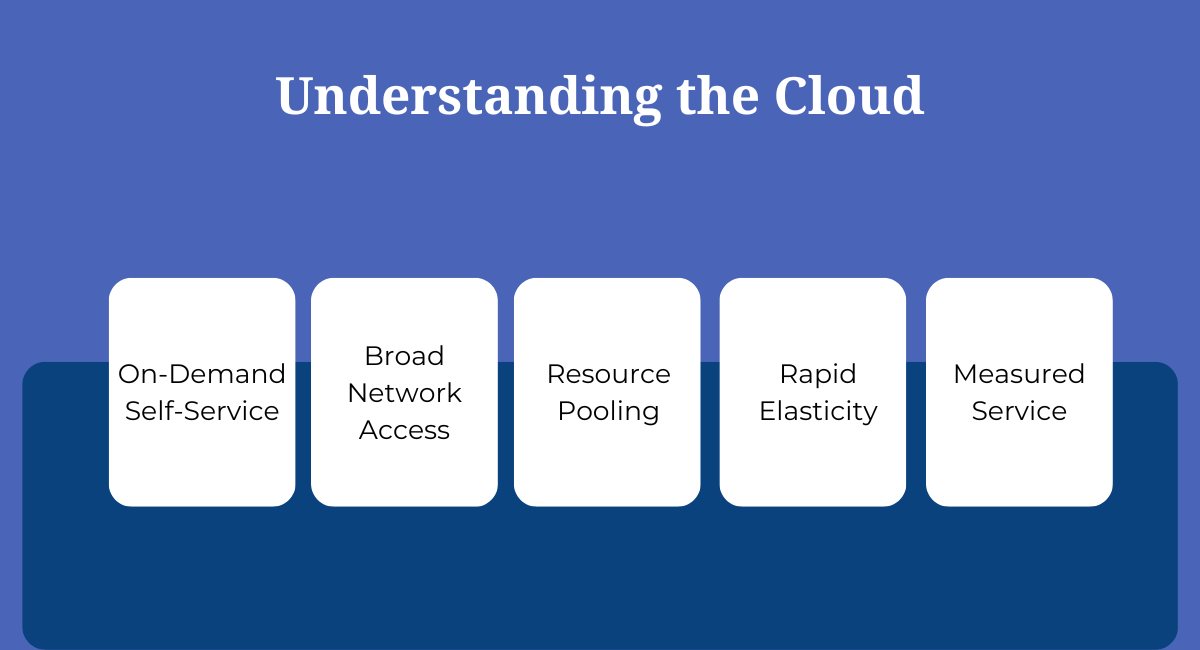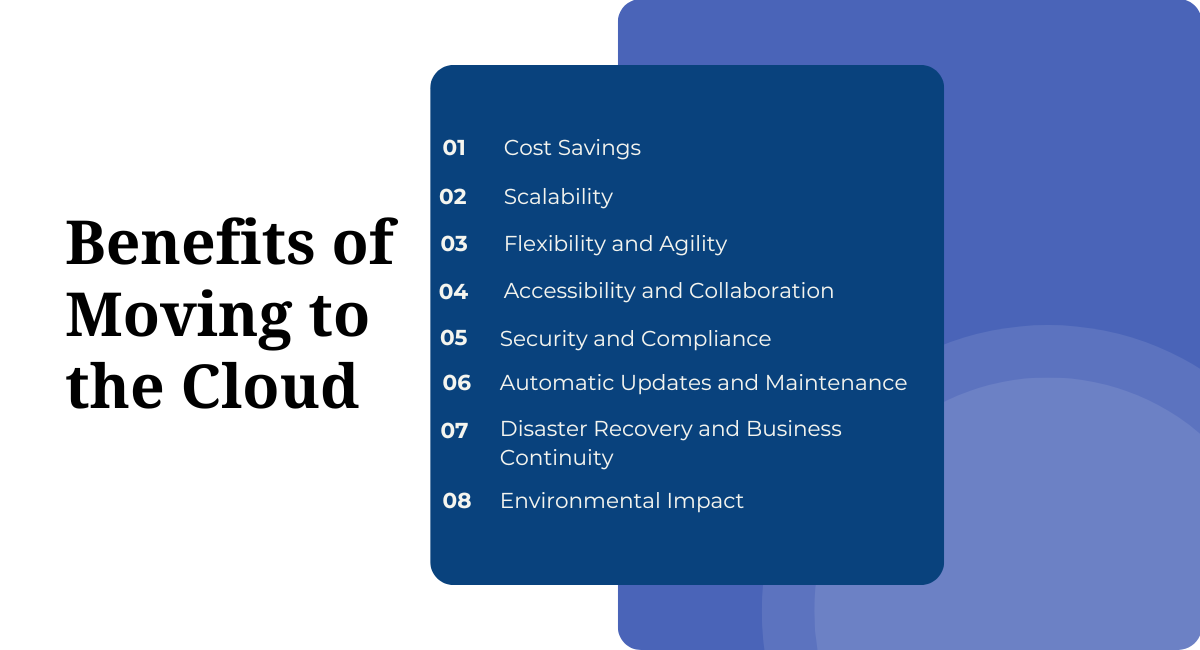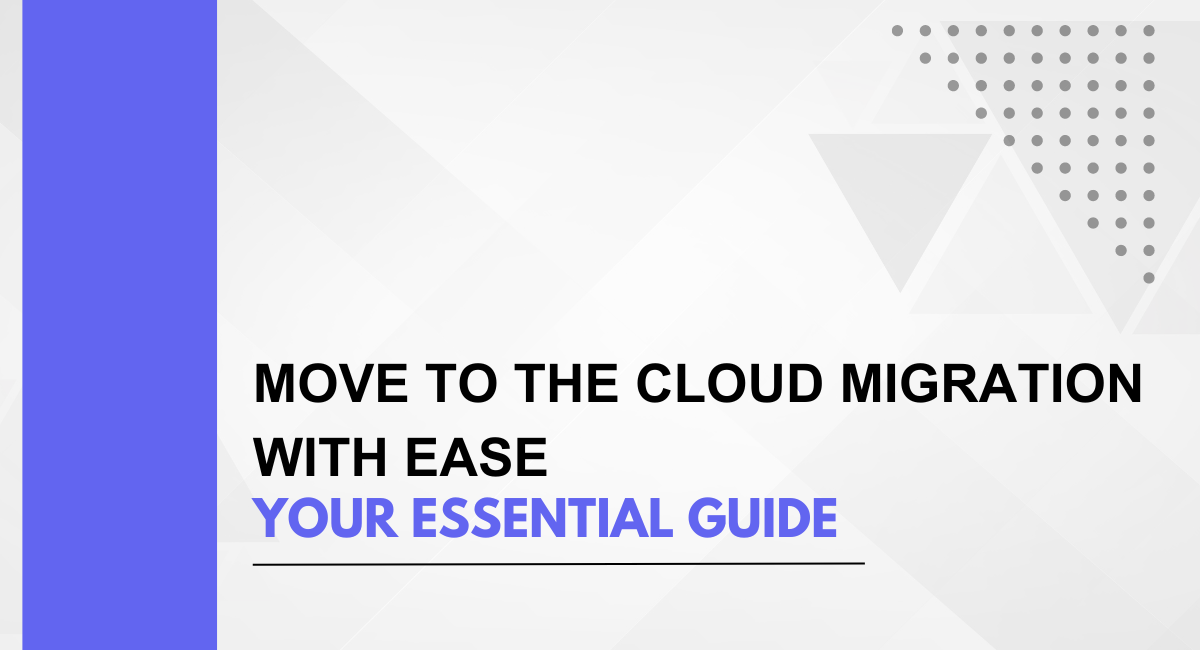Cloud migration refers to the process of moving digital assets, such as data, applications, and IT processes, from an on-premises infrastructure or legacy system to a cloud computing environment. This transition involves the transfer of resources to a cloud service provider's infrastructure, where they can be accessed and managed remotely.
Cloud migration is driven by the desire to leverage the benefits of cloud computing, including scalability, cost efficiency, flexibility, and enhanced collaboration. The Global Cloud Computing Market was valued at $495.3 Billion in 2022 and is projected to soar to $2,495.2 Billion by 2032. The Cloud Computing Market is set to expand at a CAGR of 17.8% from 2023 to 2032.
The importance of cloud migration lies in the transformative impact it can have on an organization's IT infrastructure and overall business operations. Critical reasons for undertaking cloud migration include:
- Scalability: Cloud environments offer the ability to scale resources up or down based on demand, allowing organizations to adapt to changing workloads more efficiently.
- Cost Efficiency: Cloud computing can reduce capital expenses associated with on-premises hardware and maintenance. Organizations can adopt a pay-as-you-go model, only paying for the resources they consume.
- Flexibility and Agility: Cloud platforms provide flexibility for deploying and managing applications. This agility enables faster innovation, development, and deployment cycles.
- Accessibility: Cloud services provide ubiquitous access to data and applications, allowing users to work from anywhere with an internet connection, promoting remote collaboration.
- Security and Compliance: Cloud service providers often have robust security measures in place, and they continually update and improve security protocols. This can enhance data protection and compliance with industry regulations.
- Disaster Recovery and Business Continuity: Cloud environments offer reliable backup and recovery options, helping organizations mitigate risks associated with data loss and downtime.
Understanding the Cloud

Cloud computing is a technology paradigm that involves the delivery of computing services, including storage, processing power, and applications, over the Internet. Instead of relying on local servers or personal devices to handle computing tasks, users can access and use these services through the cloud service provider's infrastructure. Key characteristics of cloud computing include:
On-Demand Self-Service:
Users can provision and manage computing resources as needed without requiring human intervention from the service provider.
Broad Network Access:
Cloud services are accessible over the Internet from a variety of devices, such as laptops, smartphones, and tablets.
Resource Pooling:
Computing resources are pooled together and shared among multiple users, with the provider dynamically allocating resources based on demand.
Rapid Elasticity:
Cloud resources can be quickly scaled up or down to accommodate changes in workload, ensuring optimal performance and cost efficiency.
Measured Service:
Cloud computing resources are metered, and users are billed based on their usage. This pay-as-you-go model promotes cost-effectiveness.
Types of Cloud Services (IaaS, PaaS, SaaS)
Infrastructure as a Service (IaaS):
IaaS provides virtualized computing infrastructure over the Internet. Users can rent virtual machines, storage, and networking components. This offers flexibility and control over the infrastructure while outsourcing the management of hardware to the cloud provider.
Platform as a Service (PaaS):
PaaS delivers a platform that allows developers to build, deploy, and manage applications without dealing with the underlying infrastructure. It includes tools and services for application development, such as databases, development frameworks, and middleware.
Software as a Service (SaaS):
SaaS delivers fully functional applications over the Internet. Users can access these applications through a web browser without needing to install, manage, or maintain the software locally. Examples include email services, customer relationship management (CRM) systems, and collaboration tools.
Benefits of Moving to the Cloud

- Cost Savings: Cloud computing eliminates the need for upfront capital expenses on hardware and allows organizations to pay only for the resources they use, reducing overall IT costs.
- Scalability: Cloud services provide the ability to scale resources up or down based on demand. This scalability ensures optimal performance during peak times and cost savings during periods of lower demand.
- Flexibility and Agility: Cloud platforms offer the flexibility to adapt to changing business needs quickly. This agility allows organizations to experiment with new ideas, develop and deploy applications faster, and respond more efficiently to market demands.
- Accessibility and Collaboration: Cloud services enable users to access data and applications from anywhere with an internet connection, fostering collaboration among geographically dispersed teams.
- Security and Compliance: Reputable cloud service providers invest heavily in security measures and compliance certifications. Utilizing their services can enhance data security and help organizations meet regulatory requirements.
- Automatic Updates and Maintenance: Cloud providers handle software updates, patches, and maintenance tasks, reducing the burden on internal IT teams and ensuring that systems are up-to-date and secure.
- Disaster Recovery and Business Continuity: Cloud services often include robust disaster recovery solutions, ensuring data backup and recovery in the event of a system failure or other disasters.
- Environmental Impact: Cloud computing can contribute to environmental sustainability by optimizing resource utilization and energy efficiency in data centers, resulting in a lower carbon footprint compared to traditional on-premises infrastructure.
By understanding the basics of cloud computing and the types of cloud services available, organizations can make informed decisions about migrating to the cloud and leverage its numerous benefits for their business operations.
Planning Your Cloud Migration Strategy
Choosing the Right Cloud Service Model
Infrastructure as a Service (IaaS):
If your organization requires control over the infrastructure and needs to manage virtual machines, storage, and networking components, IaaS may be suitable. This model is beneficial for businesses with specific requirements for customization and flexibility at the infrastructure level.
Platform as a Service (PaaS):
If your focus is on application development and you want to abstract away the underlying infrastructure management, PaaS might be the right choice. It streamlines the development process by providing tools and services for building, deploying, and scaling applications.
Software as a Service (SaaS):
When your primary goal is to leverage pre-built, fully functional applications without dealing with infrastructure or application development, SaaS is a suitable option. This model is convenient for applications like email, CRM, and collaboration tools.
Selecting the Appropriate Cloud Provider
Evaluate Services Offered:
Assess the services offered by different cloud providers. Consider factors such as computing power, storage options, databases, networking capabilities, and additional services that align with your organization's needs.
Cost Considerations:
Compare pricing models and determine which provider offers the most cost-effective solutions based on your usage patterns. Consider factors such as data transfer costs, storage costs, and any additional fees.
Performance and Reliability:
Examine the provider's track record for performance and reliability. Look for information on service-level agreements (SLAs), uptime guarantees, and the provider's ability to meet your performance requirements.
Security Measures:
Evaluate the security measures implemented by each provider. Consider features such as data encryption, access controls, compliance certifications, and the provider's commitment to security best practices.
Scalability:
Choose a cloud provider that can accommodate your organization's growth. Assess the provider's ability to scale resources up or down based on demand, ensuring that your infrastructure can adapt to changing workloads.
Geographic Presence:
Consider the global reach of the cloud provider's data centers. This is important for ensuring low-latency access and compliance with data residency requirements.
Integration Capabilities:
Assess how well the cloud provider's services integrate with your existing systems and tools. Compatibility and ease of integration can impact the efficiency of your migration.
Defining Clear Objectives and Goals
Business Objectives:
Clearly define the business objectives driving your cloud migration. Whether it's improving scalability, reducing costs, enhancing collaboration, or gaining a competitive edge, align your migration strategy with overarching business goals.
Technical Objectives:
Specify technical objectives, such as modernizing applications, improving performance, and optimizing resource utilization. Ensure that these technical goals align with the overall IT strategy of your organization.
Measurable Metrics:
Establish quantifiable metrics to evaluate the success of your migration. This may include key performance indicators (KPIs) related to cost savings, application performance, downtime reduction, and user satisfaction.
Timeline and Milestones:
Develop a realistic timeline for your migration, including critical milestones. Breaking down the migration process into manageable phases can help ensure a smooth transition and facilitate effective project management.
Risk Assessment:
Identify potential risks and challenges associated with the migration. Develop mitigation strategies to address these risks and ensure a proactive approach to handling unforeseen issues.
Stakeholder Communication:
Communicate the migration objectives, timeline, and potential impacts to relevant stakeholders, including employees, management, and customers. Effective communication fosters understanding and support throughout the migration process.
By carefully considering the cloud service model, selecting an appropriate provider, and defining clear objectives, organizations can develop a comprehensive and well-informed cloud migration strategy. This strategic approach lays the foundation for a successful migration that aligns with both business and technical goals.
Data Migration Best Practices
Preparing and Cleaning Data for Migration
Data Assessment:
Conduct a thorough assessment of your existing data. Identify and document data types, formats, and dependencies to create a comprehensive understanding of your data landscape.
Data Cleanup:
Cleanse and de-duplicate data before migration. Remove obsolete or unnecessary records to improve data quality and reduce the volume of data being migrated.
Data Mapping:
Develop a detailed data mapping strategy to understand how data elements in the source system correspond to those in the target system. This ensures accurate data transfer and consistency.
Data Validation:
Implement data validation processes to identify and rectify any inconsistencies, errors, or missing data during the preparation phase. Validation ensures that only high-quality data is migrated.
Data Documentation:
Document metadata, data dictionaries, and any transformations applied to the data. This documentation is valuable for future reference, troubleshooting, and maintaining data integrity.
Choosing the Right Data Migration Tools
Compatibility with Source and Target Systems:
Select data migration tools that are compatible with both the source and target systems. Ensure that the tools support the data formats and structures of both environments.
Scalability:
Choose tools that can scale to accommodate the volume of data you need to migrate. Scalable tools help optimize performance and minimize downtime during the migration process.
Data Mapping and Transformation:
Use tools that provide robust data mapping and transformation capabilities. These features are essential for ensuring that data is correctly mapped and transformed to match the requirements of the target system.
Automation:
Leverage automation to streamline the data migration process. Automated tools can significantly reduce the risk of human error, enhance efficiency, and accelerate the overall migration timeline.
Logging and Auditing:
Select tools that offer comprehensive logging and auditing capabilities. Detailed logs help in tracking the progress of the migration, identifying issues, and ensuring accountability.
Error Handling:
Choose tools with robust error-handling mechanisms. The ability to identify and handle errors in real time is crucial for maintaining data integrity and minimizing disruptions during migration.
Data Replication and Synchronization:
If possible, opt for tools that support data replication and synchronization. These features can be valuable for ensuring consistency between the source and target systems during the migration process.
Ensuring Data Security and Integrity
Encryption:
Implement encryption mechanisms to protect sensitive data during migration. Ensure that data is encrypted both in transit and at rest to mitigate security risks.
Access Controls:
Define and enforce access controls to restrict unauthorized access to the data migration tools and associated resources. Limit access to only those individuals who require it for the migration process.
Audit Trails:
Establish audit trails to monitor and track data access and changes. Auditing helps in identifying any suspicious activities, ensuring data integrity, and facilitating compliance with regulatory requirements.
Compliance with Regulations:
Ensure that your data migration practices comply with relevant data protection and privacy regulations. This is particularly important when dealing with sensitive or personally identifiable information.
Testing and Validation:
Perform thorough testing and validation of the data migration process to identify and rectify security vulnerabilities and ensure that data is accurately and securely transferred.
Backup and Recovery:
Implement a robust backup and recovery strategy. Regularly back up data before and during migration to prevent data loss in the event of unforeseen issues.
Data Ownership and Responsibility:
Clearly define data ownership and establish accountability for data integrity. Ensure that all stakeholders understand their roles and responsibilities in maintaining the security and integrity of the migrated data.
Move with Ease
By adhering to these principles and continuously refining cloud strategies, organizations can stay agile, competitive, and well-positioned to adapt to the dynamic landscape of cloud computing. Cloud migration is not just a destination; it's an ongoing evolution that enables organizations to thrive in the digital era.
You may also be interested in Privacy Policy | ContextQA
Book a Demo and experience ContextQA testing tool in action with a complimentary, no-obligation session tailored to your business needs.
We make it easy to get started with the ContextQA tool: Start Free Trial.
